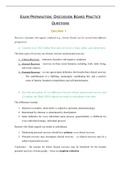EXAM PREPARATION: DISCUSSION BOARD PRACTICE
QUESTIONS
Question 1
Recovery of people who appear confused (e.g., Jeroen Zwaal) can be viewed from different
perspectives
a) Castelein et al. (2021) define three types of recovery. Name, define, and explain them.
The three types of recovery are clinical, societal, and personal recovery:
1. Clinical Recovery – remission of positive and negative symptoms
2. Societal Recovery – recovery on three social domains, including work, daily living,
and social contacts
3. Personal Recovery – no one agreed upon definition, but broader than clinical recovery
- The establishment of a fulfilling, meaningful, contributing life, and a positive
sense of identity founded on hopefulness and self-determination
b) Describe and explain (1) two differences between clinical and personal recovery and
(2) explain why Slade (2019) regards one model as subordinate to the other.
The differences include:
1. Objective (scientific, observable) vs subjective (personal, phenomenology)
2. Determined by clinician vs determined by client/patient
3. Same definition for every individual (same process, generalizable) vs Different for
every individual (unique, individual process)
Reasons why Slade regards one model as subordinate:
1. Mentioning personal recovery should have primacy over clinical recovery
2. Personal recovery may encompass clinical recovery – or clinical recovery may be a
subset of personal recovery
Conclusion – the reasons for which clinical recovery may be beneficial for the broader
personal recovery of some people – focus on symptom reduction
, - Clinical recovery can be damaging to others’ personal recovery – due to reduction
of hope, meaning, and positive aspect of symptoms
c) Describe Jeroen’s case using both the clinical and personal recovery perspective and
describe and explain two disadvantages of each perspective.
Description of case from clinical perspective – and mention at least two of the following:
1. Diagnosis 3. Reduction of symptoms
2. Symptoms 4. Determined by clinician
Description of case from personal perspective – and mention at least two of the following:
1. Domains – hope, meaning, identity and personal responsibility
2. Stages of recovery and function
3. Tasks of recovery
4. Personal Recovery Framework
Two disadvantages of clinical recovery perspective include:
1. Reduction of hope 3. Damages many people in mental
2. No room for meaning health care
4. Loss of empowerment
Two disadvantages of personal recovery perspective:
1. Concept cannot be clearly defined
2. Empirical investigation is problematic – due to focus on subjective experience and
constructivist truth
3. No common language on illness, treatment and health
Question 2
During the course you watched the expert by experience Jeroen explain his experience with
the mental health system. Consider Jeroen’s experience during the following questions.
a) In Slade (2009), three clinical sub-models were described. They each view
psychological illnesses in a certain way. (1) Describe the biomedical clinical model
, in relation to psychopathology and (2) name the two key assumptions of it. (3)
Explain how this may related to Jeroen’s confused behavior.
The biomedical model is a model of in which causal explanations of psychopathology are
thought to be rooted in biological processes
There are two key assumptions in the biomedical clinical model – including:
1. The mental illness has a single underlying biological cause – disease
2. Removal of that disease will result in return to health
In the case of Jeroen, the biomedical clinical model of psychopathology – would view his
behavior to be caused by a single underlying factor
- This model would not take into account any other psychosocial factors
b) During your pre-recorded lecture on the Recovery paradigm, the medical and
personal recovery perspectives on mental health were compared. What are the
differences between these perspectives? Elaborate on these differences, discussing at
least two differences.
Medical/Clinical Recovery
Define The medical perspective on mental health and treatment largely focuses on
impairment as the result of illness
Explain The medical perspective is typified by avoidance motivation – i.e., the motivation to
prevent symptoms from happening
- This model attempts to cure patients via symptom reduction – often viewing
patient’s difficulties from a biological or universal perspective
Personal Recovery
Define Anthony (1993) defined personal recovery as “a deeply personal, unique process of
changing one’s attitudes, values, feelings, goals, skills and/or roles – it is a way of living a
satisfying, hopeful, and contributing life even within the limitations of mental illness”
Explain Personal recovery focuses on processes such as:
1. Taking personal responsibility 2. Building hope




